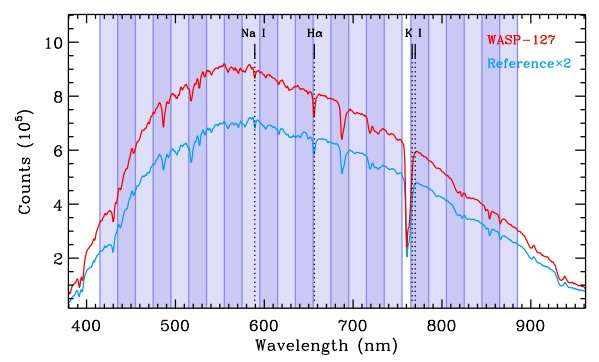June 6, 2017 report
The puffiest 'super-Neptune' has a cloud-free atmosphere, new study finds

(Phys.org)—Astronomers have recently conducted spectroscopic observations of the exoplanet WASP-127b – the puffiest "super-Neptune" known to date. The new study, presented in a paper published May 25 on arXiv.org, reveals that this alien world has an atmosphere, which is either completely or partially cloud-free.
WASP-127b was classified as a so-called "super-Neptune" as with a mass of about 0.18 Jupiter masses, it is several times more massive than the solar system's outermost planet. Due to its relatively large radius of 1.37 Jupiter radii, this exoworld is the puffiest, lowest density "super-Neptune" planet discovered to date.
It takes about 4.2 days for WASP-127b to complete one full orbit around a bright G5 star located approximately 332 light years away from the Earth. The star's brightness and its relative proximity, combined with the planet's short orbital period, make WASP-127b an excellent target for atmospheric follow-up studies.
That is why a team of astronomers led by Enric Pallé of the University of La Laguna, Santa Cruz de Tenerife, Spain, has conducted spectroscopic observations of WASP-127b utilizing the Andalucia Faint Object Spectrograph and Camera (ALFOSC). This spectrograph, mounted at the 2.5 m Nordic Optical Telescope (NOT) at Roque de los Muchachos Observatory, was used by Pallé's team in February 2017 to observe a low-resolution, long-slit spectroscopic time series during a planetary transit and to obtain the first transmission spectrum for WASP-127b.
Such observations are crucial in order to reveal insights about the atmosphere of this planet that could explain why WASP-127b is so inflated. Studying the planet's atmospheric composition could offer clues on the nature of its intriguing inflation and its evolutionary history.
ALFOSC observations allowed the researchers to find that the transmission spectrum of WASP-127b has strong spectral features. In particular, the spectrum shows the presence of a strong Rayleigh-like slope at blue wavelengths and a hint of sodium (Na) absorption.
"At the bluer wavelengths, the spectrum shows a decreasing slope with λ, which seems to indicate the presence of Rayleigh scattering. A hint of Na absorption is seen (although statistically insignificant), with the band centered on the Na doublet presenting a larger planet to star radius ratio value than the surrounding bands," the astronomers wrote in the paper.
According to the researchers, these results suggest that WASP-127b seems to have a cloud-free atmosphere. However, more detailed observations are needed to definitively confirm this finding. The team proposes follow-up studies of this planet with ground-based telescopes and space observatories, including the powerful James Webb Space Telescope (JWST), which is planned for launch in October 2018. Further observations could confirm the team's findings and extend them into the infrared regime, providing crucial information about the evolution of such inflated, low-density alien worlds.
"Finding the physical mechanism(s) responsible for this inflation will help us understand how this type of planets evolve and how their fate is tied to that of their host star," the authors concluded.
More information: A feature-rich transmission spectrum for WASP-127b, arXiv:1705.09230 [astro-ph.EP] arxiv.org/abs/1705.09230
Abstract
WASP-127b is one of the lowest density planets discovered to date. With a sub-Saturn mass (Mp=0.18±0.02MJ) and super-Jupiter radius (Rp=1.37±0.04RJ), it orbits a bright G5 star, which is about to leave the main-sequence. We aim to explore WASP-127b's atmosphere in order to retrieve its main atmospheric components, and to find hints for its intriguing inflation and evolutionary history. We used the ALFOSC spectrograph at the NOT telescope to observe a low resolution (R∼330, seeing limited) long-slit spectroscopic time series during a planetary transit, and present here the first transmission spectrum for WASP-127b. We find the presence of a strong Rayleigh slope at blue wavelengths and a hint of Na absorption, although the quality of the data does not allow us to claim a detection. At redder wavelengths the absorption features of TiO and VO are the best explanation to fit the data. Although higher signal-to-noise ratio observations are needed to conclusively confirm the absorption features, WASP-127b seems to posses a cloud-free atmosphere and is one of the best targets to perform further characterization studies in the near future.
© 2017 Phys.org



















